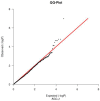Identification of Genetic Regions Associated with Scrotal Hernias in a Commercial Swine Herd
- PMID: 29382056
- PMCID: PMC5876567
- DOI: 10.3390/vetsci5010015
Identification of Genetic Regions Associated with Scrotal Hernias in a Commercial Swine Herd
Abstract
In this paper, we have used two approaches to detect genetic associations with scrotal hernias in commercial pigs. Firstly, we have investigated the effects of runs of homozygosity (ROH) with the appearance of scrotal hernias, followed by a Genome Wide Association Study (GWAS). The phenotype classification was based on visual appearance of scrotal hernias. Each affected animal was matched to a healthy control from the same pen. In the total, 68 animals were genotyped using the Porcine SNP60 Beadchip, out of those, 41 animals had the presence of hernias and 27 were healthy animals. Fifteen animals were removed from the analysis due to differences in genetic background, leaving 18 healthy animals and 35 piglets with scrotal hernia. Further, the detection of extended haplotypes shared ROH were conducted for health (control) and affected (case) animals and a permutation test was used to test whether the ROH segments were more frequent in case/case pairs than non-case/case pairs. Using the ROH, we have identified an association (p = 0.019) on chromosome 2(SSC2) being segregated on animals with the presence of scrotal hernias. Using a GWAS, a region composed by 3 SNPs on the sexual chromosome X (SSCX) were associated with scrotal hernias (p < 1.6 × 10-5), this region harbors the Androgen Receptor Gene (AR).
Keywords: SNP; genetics; hernias; swine.
Conflict of interest statement
The authors declare that they have no conflict of interest.
Figures




Similar articles
-
Genome-wide linkage analysis of inguinal hernia in pigs using affected sib pairs.BMC Genet. 2006 May 3;7:25. doi: 10.1186/1471-2156-7-25. BMC Genet. 2006. PMID: 16672048 Free PMC article.
-
A genome-wide scan reveals candidate susceptibility loci for pig hernias in an intercross between White Duroc and Erhualian.J Anim Sci. 2009 Aug;87(8):2469-74. doi: 10.2527/jas.2008-1601. Epub 2009 Apr 9. J Anim Sci. 2009. PMID: 19359506
-
Genome-wide association study using deregressed breeding values for cryptorchidism and scrotal/inguinal hernia in two pig lines.Genet Sel Evol. 2015 Mar 21;47(1):18. doi: 10.1186/s12711-015-0096-6. Genet Sel Evol. 2015. PMID: 25886970 Free PMC article.
-
SUSCEPTIBILITY LOCI FOR UMBILICAL HERNIA IN SWINE DETECTED BY GENOME-WIDE ASSOCIATION.Genetika. 2015 Oct;51(10):1163-70. doi: 10.7868/s0016675815100100. Genetika. 2015. PMID: 27169231
-
Runs of homozygosity: current knowledge and applications in livestock.Anim Genet. 2017 Jun;48(3):255-271. doi: 10.1111/age.12526. Epub 2016 Dec 1. Anim Genet. 2017. PMID: 27910110 Review.
Cited by
-
Further host-genomic characterization of total antibody response to PRRSV vaccination and its relationship with reproductive performance in commercial sows: genome-wide haplotype and zygosity analyses.Genet Sel Evol. 2021 Dec 7;53(1):91. doi: 10.1186/s12711-021-00676-5. Genet Sel Evol. 2021. PMID: 34875996 Free PMC article.
-
Altered Transcript Levels of MMP13 and VIT Genes in the Muscle and Connective Tissue of Pigs with Umbilical Hernia.Genes (Basel). 2023 Oct 1;14(10):1903. doi: 10.3390/genes14101903. Genes (Basel). 2023. PMID: 37895252 Free PMC article.
-
Multicenter retrospective study of complications and risk factors associated with castration in 106 pet pigs.Can Vet J. 2020 Feb;61(2):173-177. Can Vet J. 2020. PMID: 32020937 Free PMC article.
-
Postweaning mortality in commercial swine production. I: review of non-infectious contributing factors.Transl Anim Sci. 2020 May 21;4(2):txaa068. doi: 10.1093/tas/txaa068. eCollection 2020 Apr. Transl Anim Sci. 2020. PMID: 32705063 Free PMC article. Review.
-
Genes and SNPs Involved with Scrotal and Umbilical Hernia in Pigs.Genes (Basel). 2021 Jan 27;12(2):166. doi: 10.3390/genes12020166. Genes (Basel). 2021. PMID: 33513662 Free PMC article.
References
-
- Searcy-Bernal R., Gardner I.A., Hird D.W. Effects of and factors associated with umbilical hernias in a swine herd. J. Am. Vet. Med. Assoc. 1994;204:1660–1664. - PubMed
-
- Sobestiansky J., Carvalho L.F.O.S., Barcellos D. Malformações. In: Sobestiansky J., Barcellos D., editors. Doenças dos Suínos. 2nd ed. Cânone Editorial; Goiânia, Brazil: 2012. pp. 627–645.
LinkOut - more resources
Full Text Sources
Other Literature Sources
Research Materials

